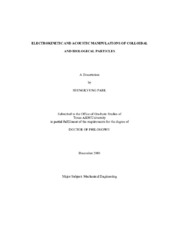| dc.description.abstract | Recent advances in microfluidic technologies have enabled integration of the
functional units for biological and chemical analysis onto miniaturized chips, called Labon-
a-Chip (LOC). However, the effective manipulation and control of colloidal particles
suspended in fluids are still challenging tasks due to the lack of clear characterization of
particle control mechanisms. The aim of this dissertation is to develop microfluidic
techniques and devices for manipulating colloids and biological particles with the
utilization of alternating current (AC) electric fields and acoustic waves.
The dissertation presents a simple theoretical tool for predicting the motion of
colloidal particles in the presence of AC electric field. Dominant electrokinetic forces
are explained as a function of the electric field conditions and material properties, and
parametric experimental validations of the model are conducted with particles and
biological species. Using the theoretical tool as an effective framework for designing
electrokinetic systems, a dielectrophoresis (DEP) based microfluidic device for trapping
bacterial spores from high conductivity media is developed. With a simple planar electrode having well defined electric field minima that can act as the targetattachment/
detection sites for integration of biosensors, negative DEP trapping of spores
on patterned surfaces is successfully demonstrated. A further investigation of DEP
colloidal manipulation under the effects of electrothermal flow induced by Joule heating
of the applied electric field is conducted. A periodic structure of the electrothermal flow
that enhances DEP trapping is numerically simulated and experimentally validated.
An acoustic method is investigated for continuous sample concentration in a
microscale device. Fast formation of particle streams focused at the pressure nodes is
demonstrated by using the long-range forces of the ultrasonic standing waves (USW).
High frequency actuation suitable for miniaturization of devices is successfully applied
and the device performance and key parameters are explained.
Further extension and integration of the technologies presented in this
dissertation will enable a chip scale platform for various chemical and biological
applications such as drug delivery, chemical analyses, point-of-care clinical diagnosis,
biowarfare and biochemical agent detection/screening, and water quality control. | en |


